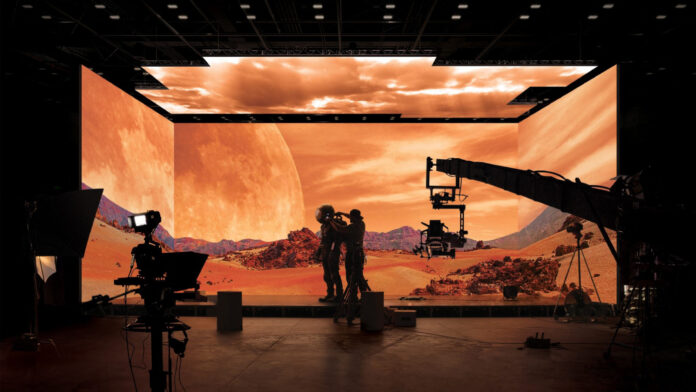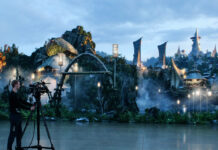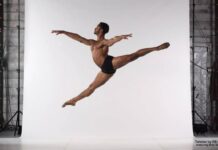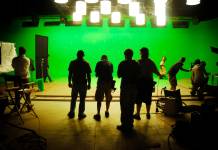In a nutshell
Virtual production continues to advance in the entertainment industry, impacting filmmakers at all levels. This technology offers filmmakers an ever-growing toolset and paves new ways for those filmmakers to tell their stories.
But how exactly is virtual production changing the industry? In this article, we delve deeper into the pervasive influence of virtual production, elucidating its enduring rise, its substantial impact on the industry and how it persistently redefines the contours of entertainment.
What exactly is virtual production?
Virtual production is a broad term in filmmaking that refers to a spectrum of computer-based techniques used during the production process. These include virtual reality (VR), augmented reality (AR) and real-time game engines. Essentially, virtual production is a technique that blends live-action footage with computer-generated imagery (CGI).
This process often includes creating and manipulating digital environments in real time, sometimes while physically present on a sound stage. Instead of waiting until post-production to integrate special effects and digital enhancements, filmmakers can now visualize these elements during the principal filming itself.
Let’s get technical
Virtual production relies on a combination of advanced technologies to merge real and virtual worlds. At the core of this technique are real-time rendering engines such as Unreal and Unity. These engines generate and render high-quality CGI instantly. Such a process enables filmmakers to see virtual elements integrated with live-action footage as soon as it’s recorded.
Large LED video walls or screens also play a crucial role in virtual production. These dynamic screens display photorealistic virtual backgrounds or sets instantly and respond to camera movements. These screens provide actors and the production team with realistic visual references.
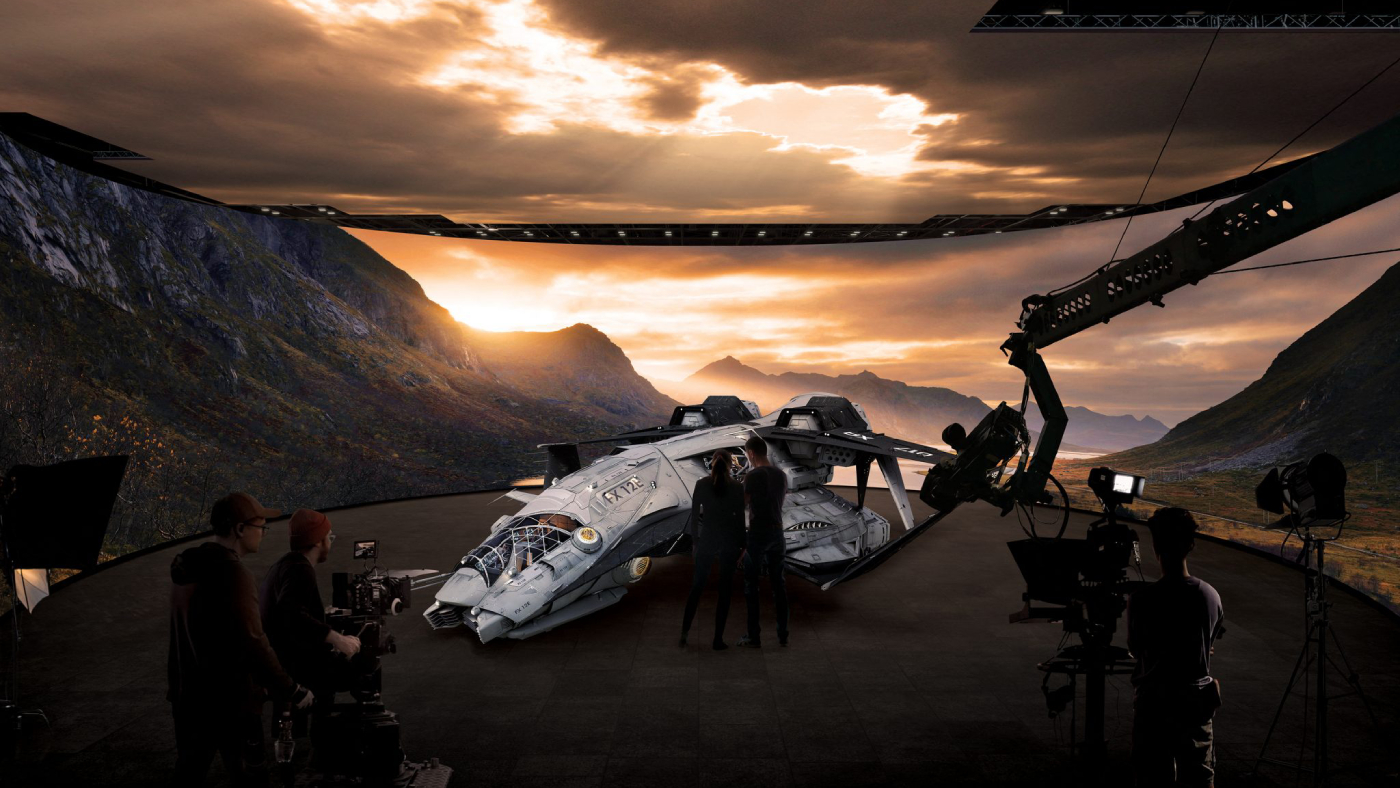
Motion capture technology is another key component. Sensors and cameras capture the movements and expressions of actors, turning them into digital data. This data can be applied to virtual characters or used as a reference for the creation of CGI elements. Recording like this ensures lifelike, natural movements within the virtual environment. Virtual cameras provide creators with the same level of control and creativity as traditional cameras but within the virtual environment.
In preproduction, previsualization software allows filmmakers to plan and see scenes in advance. Creating rough digital versions of shots, including virtual characters and environments, helps guide the filming process. Decision-making becomes more informed.
Finally, real-time compositing techniques merge live-action footage with CGI elements instantly, cutting back on the need for more post-production work. This enables directors and cinematographers to see the final composition during filming.
Let’s explore the process
The virtual production process typically begins with the previsualization phase. Here, scenes are planned and visualized digitally before shooting begins. This allows filmmakers to make significant creative decisions regarding framing, lighting and camera movement, reducing the uncertainty often associated with traditional filming.
Next is the real-time production phase. Using LED walls or green screens, filmmakers can project pre-designed environments onto the screens while actors perform in front. The scenes are then captured in-camera, along with the digital backgrounds, thus reducing the need for extensive post-production work. The simulation of natural lighting and the creation of realistic CGI characters are then handled in the post-production stage. In addition, VFX artists, compositors and other members of the post-production team finalize all the visual elements, ensuring the seamless integration of all components into a singular, cohesive narrative.
Ultimately, all of this cuts down the amount of work in post-production.
Where has virtual production already succeeded?
Virtual production techniques are currently at work in various corners of the filmmaking industry, demonstrating their applicability across a spectrum of projects and genres.
“The Mandalorian” (2019 – present)
For example, the Star Wars TV series “The Mandalorian” represents one of the most prominent examples of virtual production. The show’s creators used a technology called StageCraft, developed by Industrial Light & Magic (ILM). This innovative approach enabled actors to interact with virtual environments during their performances. Additionally, filming for The Mandalorian relied heavily on a massive LED video wall known as “The Volume.” The Volume, since used in other Disney productions, made up the entire set. It displayed high-resolution digital backdrops in real time while responding to the camera’s movement. The instant rendering capability of The Volume allowed the director and cinematographer to make quick adjustments to things like lighting and camera angles. Additionally, the virtual environments could be visualized and modified in advance, facilitating efficient planning and reducing future work.
“The Lion King” (2019)
In a similar vein, “The Lion King” (2019) leveraged advanced virtual production technology to pioneer an innovative filmmaking approach. Director Jon Favreau and his team used extensive photographs to design a detailed 3D model of the African savannah. They animated these models, infusing life into the digital environment. However, the true innovation was in how the film was shot. The team built a virtual reality landscape from these 3D models, allowing filmmakers to don VR headsets and explore the environment as if on a physical film set. They could employ handheld controllers as virtual cameras, planning shots and sequences in real time. Thus, while most of “The Lion King” was entirely computer-generated, the process resembled a live-action film shoot, blending traditional filmmaking techniques with the latest in virtual production technology.
“Avatar 2” (2023)
For “Avatar 2” (2023), Director James Cameron used a combination of motion capture and underwater filming for the project. Cameron used sophisticated motion capture systems to record the actors’ performances. These were then translated into the film’s digital characters. Another key component was the use of real-time rendering. This technology allowed the filmmakers to visualize the digital environments and characters immediately during filming, providing immediate feedback and the ability to make adjustments on the spot.
An efficient alternative to traditional filmmaking
Virtual production doesn’t just create a blend of real and virtual footage. It’s also highly cost-effective and efficient. It even cuts back on waste.
In big-budget productions, tens or hundreds of sets are built, and tons of costumes and props may be produced. Demolished sets produce significant waste. But with virtual production, sets are confined to 3D virtual spaces and virtual assets are spared the landfill. Actors and crews don’t need to fly to location, significantly cutting back on travel emissions. Reshoots, usually a big portion of the final production cost, are cut through real-time adjustments and immediate visual feedback.
The future is virtual
Virtual production is a critical tool for so many major productions today. While a lot of this technology is currently only available to big production studios, the technology will continue to advance. As it advances and becomes more widely available, more companies will reap the benefits of this technology.
Virtual production represents a paradigm shift in the very nature of filmmaking. It brings about enhanced creative control, time efficiency, and cost-effectiveness, all while reducing logistical constraints. With the success stories of high-profile projects such as “The Mandalorian,” “The Lion King,” and “Avatar 2,” the application and benefits of virtual production are becoming increasingly apparent. Moreover, as this technology becomes more accessible, we can expect a ripple effect throughout the industry. Furthermore, the development of new, immersive mediums, such as virtual and augmented reality, will propel virtual production forward.
Feature image courtesy: Samsung

